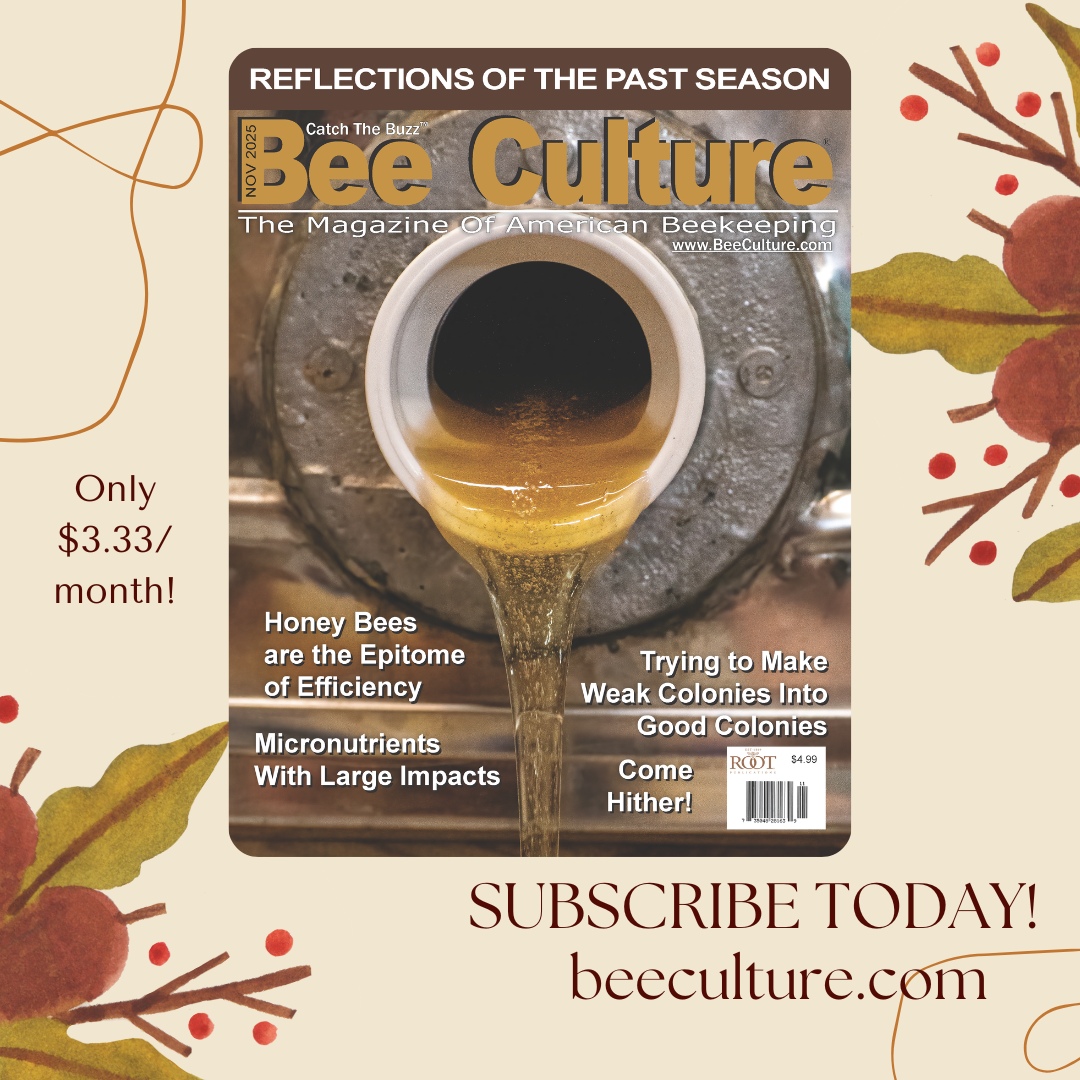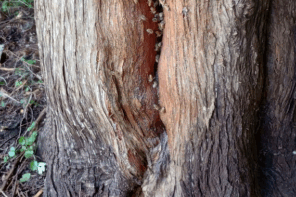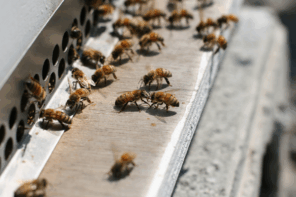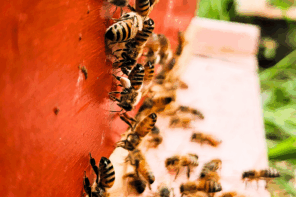By: Ann Harman
This article originally appeared in the Summer 2016 issue of BEEKeeping Your First Three Years
HIVE TASKS – First Year Beekeepers
April, May, June
Goal – all comb drawn by end of June, colony numbers increasing
1. Feed package bees or nucs 1:1 sugar syrup.
2. Feed pollen patties until fresh pollen is available.
3. In small hive beetle (shb) areas, use caution with pollen patties.
4. Watch returning bees at entrance for evidence of pollen collection.
5. Keep entrances small until colony numbers increase.
6. Inspect hives only when weather permits – warm sun, low wind, temperature above 60°F.
7. Keep colony inspections as brief as possible.
8. Inspect for presence of queen from eggs, young larvae.
9. Monitor queen performance with brood pattern.
10. Replace queen if original is dead or is not laying enough eggs to increase colony numbers.
11. Lightly spray foundation (Langstroth hives) with 1: 1 sugar syrup with Honey-B-Healthy® to stimulate drawing comb.
12. Move follower board (top bar hives) to keep up with comb construction.
13. Add next brood chamber (Langstroth hives) only when previous one has 90% drawn comb.
14. Do not consider a honey harvest until all brood chambers have 100% drawn comb and colony is full of healthy bees.
15. Bottled sugar syrup is not honey! Do not put honey supers on when feeding syrup.
16. Learn seasonal nectar and pollen plants in your area.
17. Learn about your bees’ foraging area whether urban, suburban or rural.
HIVE TASKS – 2nd and 3rd Year Beekeepers
April, May, June
1. Spring hive cleaning time!
2. Select a day with warm sun, low wind to inspect hives, top to bottom.
3. Clean off Winter debris from bottom board, whether solid or screen.
4. Clean up underneath hives.
5. Clean up apiary and inspect bear fence.
6. Repair or replace any hive parts that have Winter damage.
7. Select frames (Langstroth) or bars (top bar hives) with poor or old comb for replacement.
8. Wait to replace old combs until strong nectar flow.
9. If replacing comb with foundation spray foundation with 1:1 sugar syrup with Honey-B-Healthy® to stimulate comb building.
10. Inspect brood pattern and assess colony numbers – does queen need replacement now?
11. A weak colony, disease-free, can be combined with another colony.
12. Kill queen in weak hive to be combined.
13. If any disease suspected, have local apiary inspector or experienced beekeeper inspect colony.
14. If in small hive beetle (shb) area, keep further hive inspections to a minimum and use shb control methods.
15. Use your preferred method of swarm prevention. Brood chambers can be reversed at this time if bottom brood chamber is empty.
16. Do not split brood sphere when reversing.
17. Continue reversing until nectar flow starts.
18. Do you know your Spring nectar and pollen plants? If not, learn them.
19. Are you in an area with Spring nectar flow for honey production?
20. Have honey supers ready to put on hives.
21. Monitor the weather during strong nectar flow increase or decrease honey supers as needed.
What Do You Mean?
Beekeeping has a language, as does golf (what’s a ‘birdie’?), tennis (lots of ‘love’) and other pastimes. Learning the correct terms is like learning a new language. Beekeeping terms should help us understand each other as we discuss what we see and what we do. Long-time beekeepers tend to be careless with terms. Unfortunately new beekeepers who take classes taught by long-time beekeepers may be taught some wrong words. Such carelessness can cause great confusion when a new beekeeper asks a question and gets a response that may not make sense. As a new beekeeper you need to learn the correct terms so you can ask questions and even read the websites and equipment catalogs.
Some words never seem to be confused. ‘Smoker’ and ‘hive tool’ are quite universal although there are many styles of hive tools. Queen, worker and drone keep those names with no substitutes for them. Let’s look at the confusing terms.
The ‘hive’ versus the ‘colony.’ The hive is actually the wood (or plastic) home for the bees. The colony is the group of bees themselves. These two words are very frequently used interchangeably. Beekeepers will ask ‘how is that weak hive doing?’ when they actually mean ‘weak colony.’ In the same way you will hear ‘it is time to inspect the hive’ – meaning the bees, the colony. Usually any confusion with these two terms is easily sorted out.
The Langstroth hive itself can be very confusing. Some terms do not cause much confusion but others are very confusing. The bottom board can be either screened or solid. Not much problem there. The top cover can be called a telescoping cover because it has a rim that fits down over the rest of the hive. Little problem there also. The inner cover comes in different styles but it is still called an inner cover, By the way it allows the telescoping cover to be removed easily.
Now for the rest of the hive. It is a series of ‘boxes’ that is an allowable term but does not describe very much. These boxes can come in several depths and widths. Widths can be 7-frame, 8-frame or 10-frame. The ‘deep’ is the deepest box; the ‘medium’ gets called ‘half-depth’ (it 1s not half of anything) or ‘medium.’ The word ‘medium’ seems to be in more common use. Then there is the ‘shallow.’ If the boxes are used for the place where the bees actually live they can be called ‘brood boxes’ or even ‘brood chambers.’ But sometimes they are called ‘hive bodies.’
What about the boxes that you will place on top of the brood boxes to collect honey for your honey harvest? Here is where problems abound. The correct term is ‘super’ or ‘honey super.’ Because it is superimposed on the brood boxes. However many, many beekeepers call every box a ‘super.’ Such use of ‘super’ can be very confusing. Learn the correct terms for these boxes and use them and you will be understood.
Queen cups and queen cells are not the same thing. The bees make little beeswax cups, a few of which may be on the face of the comb all the time. The bees can use these to make a new queen. Most of the time the cups are not in use. But the minute an egg is laid in a cup, the bees start to construct the queen cell, a long, textured cell. Just remember – small and empty is a cup.
We even give a number of terms to honey. You will hear such descriptions as crystallized, granulated, candied, sugared and solidified. All five terms given to honey that is no longer 100% liquid but has started to form crystals. The best term would be ‘crystallized.’
Next come some beekeeping actions that you can do for a variety of reasons. However, many terms can be used and can frequently be heard in the same sentence. You can take a colony and make – a nuc, a split, a divide and even an artificial swarm. You are taking some frames with brood, food and some bees from one colony to create another colony. Four terms for the same thing.
It might be a good idea to make yourself a little dictionary to keep the beekeeping terms straight.
Learn To Be a Weather Watcher and a Plant Watcher
Being a beekeeper means you will learn some new things in order to be a good steward of those bees. Becoming a Weather Watcher and a Plant Watcher are important for the success of your colonies. You should be keeping some records of your visits to and other observations of your hives. Now you are going to add some weather and plant records to that.
Since weather affects the plants that affect your bees and your beekeeping, you need to become both a Weather Watcher and a Plant Watcher. By the way ‘plants’ not only means small ones growing on roadsides and in gardens but also includes trees.
Weather affects what the bees are doing and what the plants are doing. Bees are dependent on plants for their food supplies – during their buildup of population in the Spring, during the collection of food for daily use and during storage of food for Winter. Yes, weather affects the plants that you will want for a honey harvest.
Normally people are just concerned with daily weather. Look out the window – raining. Better take a raincoat. Open the front door – whew! It’s hot! No jacket needed today. Listen to TV or radio – severe cold snap due – where are my wooly gloves?
If you are going to be a true Weather Watcher the weather today is only a small part of what you need to do as a beekeeper. Yes, today’s weather may influence whether you will open up a hive today to see how the colony is doing. But Weather Watching, keeping records, involves yesterday, last month, perhaps the months before that and what the forecasts are for the next several weeks. Even if prediction mistakes are made, the trend can be important.
Those with vegetable and flower gardens are already sort of Weather Watchers and Plant Watchers. Look – the tomato plants are a bit wilted. Better water the garden. If you have been paying attention to your vegetable and flower gardens you are on the way to being a good beekeeping Weather Watcher and Plant Watcher.
Let’s look at various aspects of weather and how it affects the plants and also the bees. Rain in moderation is beneficial. Now we need to see what happens with prolonged rain, too many days of rain, too much rain. lf it is raining and the temperatures are about 60°F or above the bees will not be flying as they would if the sun were shining. A raindrop can knock a bee out of the air. When a rain shower is over the bees will resume flying. A day of rain will keep the bees in the hive all day. They will be eating from their honey and pollen stored in the comb. Endless days of rain mean their food stores could be severely depleted. Depending on the population of bees in the hive, the time of year and the climate, it could be necessary to feed the bees. Feeding them during times of stress does not make bees lazy. Feeding them can save their lives!
Too much rain does affect the plants. Many plants do not do very well in overly-wet soil. Roots that are sitting in pools of water in waterlogged ground for a prolonged time can decay thus affecting the entire plant. Roots that are taking up too much water and sending it to the rest of the plant can mean nectar can become dilute. Honey bees search for nectar with a good sugar content and will ignore blossoms that offer very dilute nectar. So nectar sources can diminish with an unusual increase in rain.
Rainstorm with wind can be very detrimental to blossoms that are fragile. The weight of rain plus snapping about in the wind means the ground can be covered with the soggy remains of the bees’ former food supply. If those blossoms were to be the source of a honey crop for you, your honey supers will remain empty.
Now look at the opposite weather condition – not enough rain. This situation can be short term or long term. That is why you need some records about the rainfall in your particular area. Severe droughts, ones that last a month or more, or even years, are usually given attention on radio and television news. However, depend on your records to give the situation in your own area.
In a drought the plants really suffer. Growth of the plant is slowed and blossoms can be small and sparse. The nectar supply will be minimal or simply stop. Small blossoms will not have the usual quantity of pollen. So scout bees in search of a good supply of food will be searching far and wide to find suitable supplies. In severe droughts the plants may just wither and die. You may be able to save the tomato plants in your backyard garden but the bees can be starving.
Here again is a situation that means feed your bees. They may be visiting the well-watered plants in your flowerbeds but that is not enough to sustain a colony. Remember the adage – 2 million blossoms visited makes one pound of honey. If you live in an area with predictions of very long-term drought it would not be wise to increase your number of colonies. Bees need pollen as well as nectar. If your environment cannot sustain the bees their lives are up to you.
Do you live in a climate that has snow during the Winter? That counts as rain when the snow melts. Yes it is possible to have a ‘Winter snow’ drought when the weather is cold but little or no snow Falls. So Spring plants, including trees and shrubs, can be affected. In hot desert areas the plants will burst into bloom after a rainstorm. So you can have a drought there if the storms do not occur.
Now we are going to consider microclimates. Your radio and TV weather reports are for the overall area you live in. But within that area are small areas that do not exactly match the reports given. These are microclimates and are areas affected by elevation, forests, open land, hills, mountainsides, actually anything that can modify temperature and wind and even rainfall. Cities can have these just as out in the countryside. In urban and suburban areas the buildings, houses, and paved areas can create microclimates. As you start to be a Weather Watcher and Plant Watcher you will become aware of these microclimates.
Flower garden plants are identified because you bought what you wished and planted them. In urban areas the parks are filled with familiar garden plants. Do you know what the wildflowers are in your area? What about identifying the trees? You need to have a good field guide for wildflowers and one for trees. Then you will be prepared for your bees’ food needs and also for your honey crop.
After you learn the nectar and pollen sources of your particular area, find yourself some ‘target’ trees and wildflower areas. These target plants can be in or near your apiary or in areas you frequent. Then, using your Weather Watching skills you now are becoming a Plant Watcher. In temperate climate areas a target tree can tell you that early blossoms are appearing, perhaps a good pollen source. In rural areas a field covered with goldenrod can mean good Winter stores for the colony.
Don’t ignore roadsides and highway medians. People-meaning not only beekeepers but also those interested in saving all pollinators-are encouraging the various states’ Department of Transportation to stop so much mowing and plant pollinator-friendly trees and flowers. As you drive down roads and highways start watching for blooming plants (please don’t run off the road into a ditch).
These plants can help you recognize the effects of rain and drought in the area where your bees are foraging. Even if some plants are not usable by bees they do indicate effects of weather. In a drought the plants will be shorter than normal, blossoms fewer and smaller also. They are indicating that you need to check your hives for adequate food.
As you are plant watching, keep microclimates in mind. Yours can be cooler than an area near you, or warmer. It can take a year or two to know your microclimate. Sometimes common garden plants can help you. Did your Spring bulbs, such as jonquils, bloom earlier or later than ones just two miles away?
In cities the parks frequently have built-in watering systems to prevent droughts from injuring the plants. If you are keeping bees in an urban environment, plan to go by your nearby parks occasionally to do a bit of Plant Watching. Your bees may be finding enough food in the flowerbeds there.
You may wish to raise some bee-beneficial plants for your bees. You need to choose ones for your particular climate. A comprehensive book is available: Garden Plants for Honey Bees by Peter Lindtner, published by Wicwas Press. Just remember – two million blossoms for one pound honey! Many pollinators will appreciate your flowerbeds but you need to plant acres to adequately feed your bees. However, watching honey bees at work, as well as other pollinators, is fascinating.
You need some way of keeping records. Perhaps you would like an attractive wall calendar to make brief notes on rainfall, temperatures, plants. Or you could use your computer. Whatever you choose be certain to keep it going. And save this year’s entries to compare with the following year. As you progress in your beekeeping you can add a note about your honey crop for that year. Being a Weather Watcher and a Plant Watcher will help keep your bees alive, well fed and productive.
10 Reasons You Should Attend a Local Bee School
By: Dewey Caron
1. Bee School is the “fast track” to learning about both the science – bee biology – and the Art – applying the Basic Biology – to help you accomplish your beekeeping goals AND bee school will help you better define your goals and expectations.
2. It will occur to you while driving home and in the re-telling of the school events to other family members that “I learned something”…You will now know the answer to that nagging question why do bees do…
3. You will be able to understand why experience helps one – ‘Anticipation rather than React’ when it comes to colony care.
4. Bee school will help you better understand the honey bee’s seasonal cycle and you will hear how to put such information to use within the next month in your colony management.
5. You will be looking in bee colonies with the practiced eye of Masters and, at some point, realize how “easy” and “fun” beekeeping really can be.
6. You will make new friends and have opportunity to network among beekeepers.
7. You will learn about good “deals” from speaking with vendors and other beekeepers – who will welcome your questions about bees and bee equipment.
8. You will have the opportunity to connect to an ongoing information channel of the latest mite control treatments and techniques and be at the forefront of bee “issues” that arise.
9. You will find out a reason why your bees may have swarmed or “have gone away” (or may do so this year)
10. You will be a part of doing something positive for the bees and for yourself (and maybe even influence your husband/wife/child/brother-in-law) because maybe they secretly also want to become a beekeeper.









